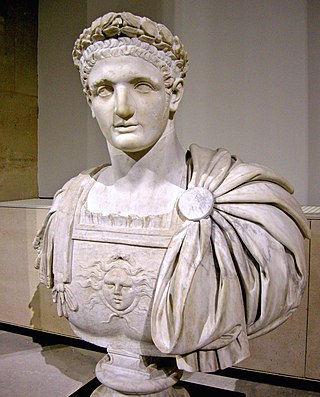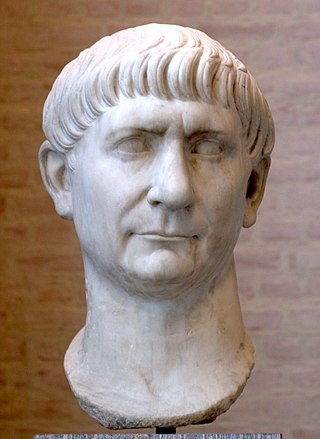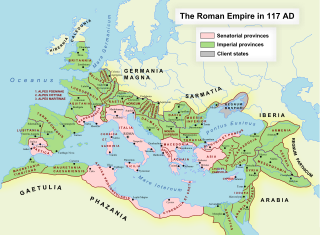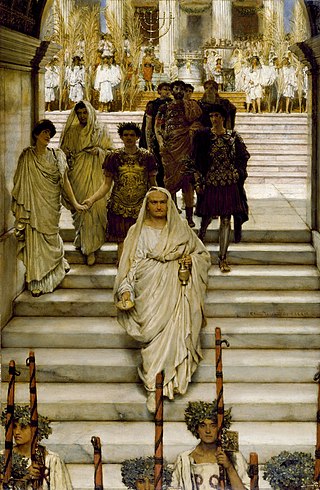
Domitian was Roman emperor from 81 to 96. The son of Vespasian and the younger brother of Titus, his two predecessors on the throne, he was the last member of the Flavian dynasty. Described as "a ruthless but efficient autocrat", his authoritarian style of ruling put him at sharp odds with the Senate, whose powers he drastically curtailed.

Trajan was a Roman emperor from AD 98 to 117, remembered as the second of the Five Good Emperors of the Nerva–Antonine dynasty. He was a philanthropic ruler and a successful soldier-emperor who presided over one of the greatest military expansions in Roman history, during which, by the time of his death, the Roman Empire reached its maximum territorial extent. He was given the title of Optimus by the Roman Senate.

The 90s was a decade that ran from January 1, AD 90, to December 31, AD 99.

The 100s was a decade that ran from January 1, AD 100, to December 31, AD 109.
AD 96 (XCVI) was a leap year starting on Friday of the Julian calendar. At the time, it was known as the Year of the Consulship of Valens and Vetus. The denomination AD 96 for this year has been used since the early medieval period, when the Anno Domini calendar era became the prevalent method in Europe for naming years.
AD 92 (XCII) was a leap year starting on Sunday of the Julian calendar. At the time, it was known as the Year of the Consulship of Augustus and Saturninus. The denomination AD 92 for this year has been used since the early medieval period, when the Anno Domini calendar era became the prevalent method in Europe for naming years.
Year 101 (CI) was a common year starting on Friday of the Julian calendar. At the time, it was known as the Year of the Consulship of Traianus and Paetus. The denomination 101 for this year has been used since the early medieval period, when the Anno Domini calendar era became the prevalent method in Europe for naming years.

Year 117 (CXVII) was a common year starting on Thursday of the Julian calendar. At the time, it was known as the Year of the Consulship of Niger and Apronianus. The denomination 117 for this year has been used since the early medieval period, when the Anno Domini calendar era became the prevalent method in Europe for naming years.
Sextus Julius Frontinus was a Roman civil engineer, author, soldier and senator of the late 1st century AD. He was a successful general under Domitian, commanding forces in Roman Britain, and on the Rhine and Danube frontiers. A novus homo, he was consul three times. Frontinus ably discharged several important administrative duties for Nerva and Trajan. However, he is best known to the post-Classical world as an author of technical treatises, especially De aquaeductu, dealing with the aqueducts of Rome.

The Praetorian Guard was the imperial guard of the Imperial Roman army that served various roles for the Roman emperor including being a bodyguard unit, counterintelligence, crowd control and gathering military intelligence.
Legio XXI Rapax was a legion of the Imperial Roman army. The symbol of the legion is thought to have been a capricorn.

The Flavian dynasty, lasting from AD 69 to 96, was the second dynastic line of emperors to rule the Roman Empire following the Julio-Claudians, encompassing the reigns of Vespasian and his two sons, Titus and Domitian. The Flavians rose to power during the civil war of AD 69, known as the Year of the Four Emperors; after Galba and Otho died in quick succession, Vitellius became emperor in mid 69. His claim to the throne was quickly challenged by legions stationed in the eastern provinces, who declared their commander Vespasian emperor in his place. The Second Battle of Bedriacum tilted the balance decisively in favor of the Flavian forces, who entered Rome on 20 December, and the following day, the Roman Senate officially declared Vespasian emperor, thus commencing the Flavian dynasty. Although the dynasty proved to be short-lived, several significant historic, economic and military events took place during their reign.

Histories is a Roman historical chronicle by Tacitus. Written c. 100–110, its complete form covered c. 69–96, a period which includes the Year of Four Emperors following the downfall of Nero, as well as the period between the rise of the Flavian dynasty under Vespasian and the death of Domitian. However, the surviving portion of the work only reaches the year 70 and the very beginning of the reign of Vespasian.

The Nerva–Antonine dynasty comprised seven Roman emperors who ruled from AD 96 to 192: Nerva (96–98), Trajan (98–117), Hadrian (117–138), Antoninus Pius (138–161), Marcus Aurelius (161–180), Lucius Verus (161–169), and Commodus (177–192). The first five of these are commonly known as the "Five Good Emperors".
Casperius Aelianus served as Praetorian Prefect under the emperors Domitian and Nerva. He was loyal to the Roman Emperor Domitian, the last of the Flavian dynasty. After Domitian's murder and the ascension of the Emperor Nerva, Aelianus laid siege to the Rome in order to force the capture of the men responsible for Domitian's death, who had not been punished by Nerva. Aelianus succeeded in his demands, greatly weakening the authority of the Emperor so much that Nerva realized that his position was no longer tenable without the support of an heir who had the approval of the Roman army. Within two or three months Nerva announced the adoption of the highly respected general Trajan as his successor.

The history of the constitution of the Roman Empire begins with the establishment of the Principate in 27 BC and is considered to conclude with the abolition of that constitutional structure in favour of the Dominate at Diocletian's accession in AD 284.

The Cancelleria Reliefs are a set of two incomplete bas-reliefs, believed to have been commissioned by the Roman Emperor Domitian. The reliefs originally depicted events from the life and reign of Domitian, but were partially recarved following the accession of emperor Nerva. They are now in the Vatican Museums.

Publius Cornelius Tacitus, known simply as Tacitus, was a Roman historian and politician. Tacitus is widely regarded as one of the greatest Roman historians by modern scholars.

Nerva was a Roman emperor from 96 to 98. Nerva became emperor when aged almost 66, after a lifetime of imperial service under Nero and the succeeding rulers of the Flavian dynasty. Under Nero, he was a member of the imperial entourage and played a vital part in exposing the Pisonian conspiracy of 65. Later, as a loyalist to the Flavians, he attained consulships in 71 and 90 during the reigns of Vespasian and Domitian, respectively. On 18 September 96, Domitian was assassinated in a palace conspiracy involving members of the Praetorian Guard and several of his freedmen. On the same day, Nerva was declared emperor by the Roman Senate. As the new ruler of the Roman Empire, he vowed to restore liberties which had been curtailed during the autocratic government of Domitian.
Lucius Maecius Postumus was a Roman senator, who held several offices in service to the emperor. He was suffect consul in the nundinium of July-August 98 as the colleague of Aulus Vicirius Martialis. Postumus is known entirely from inscriptions.












